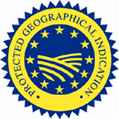Bulgaria is situated in south east Europe and is part of the Balkan Peninsula at the latitude of 42° N to 44° N. Romania is on its northern border with Greece and Turkey on its southern border. Macedonia is to the south west with Serbia and Monte Negro to the west. The eastern border faces the Black Sea.
Wine and Bulgaria go back to the Thracian times of 5000BC. Thracian tribes, from today’s Thracian Lowlands, were producing a wine they called Zelus for use in their religious ceremonies. The wine was made for their god, Dionysus. The Zelus wine was an interesting blend of concentrated red wine with honey added as a sweetener.
Bulgaria has five wine growing regions:
1) Danube Plain Region (Northern Bulgaria)
2) Thracian Lowlands Region (Southern Bulgaria)
3) Black Sea Region (Eastern Bulgaria)
4) Strouma Valley Region (South Western Bulgaria)
5) Rose Valley (Sub Balkan)
Danube Plain Region
This area is located in Northern Bulgaria between the Danube River, the foothills of the Balkan Mountains on the south, the Timok River on the west and the Black Sea on the east. The region has a continental climate with cold winters and dry hot summers. The soil on the lowland terrain is the fertile black soil (Chernozems). On the hills and mountain land the soil is the grey fertile forest soil.
White Grape Varieties Grown in the Danube Region
Sauvignon Blanc, Muscat Ottonel, Chardonnay, Traminer, Dimyat, Misket Red, Rhine Riesling, Tamyanka, Pinot Gris, Ugni Blanc, Riesling Italian, Rkatzitel, Aligote, Viognier, Furmint, Harsh Lavelyu, Sungulare Misket, Varna Musket, Misket Markov, Silvaner, Muller Tyurgao, Muscat Kailashki, Cheninille Blanc, Roussanne, and Columbard.
Red Grape Varieties Grown in the Danube Region
Cabernet Sauvignon, Cabernet Franc, Merlot, Pinot Noir, Gamay Noir, Pamid, Bouquet, Syrah, Rubin, Cinsault, Eumolpia, Grenache, Hebros, Alicante Bouschet, Grand Noir, Gamza, Camenere, Petit Verdot, Malbec, and Grenache
Thracian Lowlands Region
This area is located between the Balkan Mountains on the north, the Black Sea on the east and Greece on the south. The climate is a mix of Continental with Mediterranean influences from the Black Sea giving the proper amount of rain during the growing season. The Balkan Mountains protect the vineyards from the strong winds from the north. The soils of this flat and hilly region contain mainly a fertile soil named acidic cinnamon forest (Chromic Luvisols). Some fertile black soil (Chernozems) can also be found. The Mavrud grape variety finds its home here in the Thracian Lowlands.
The Mavrud wine is noted in many legends. From the Middle Age, there is a legend that  says that Mavrud was a young warrior from the army of Khan Tervel. He was unbeatable in battle and he gained his strength from the wine later called Mavrud. The grape is found in Plovdiv and the nearby town of Assenovgrad. The grape was also known to be a sacred plant and a symbol of the Thracian god-Dionysus.
says that Mavrud was a young warrior from the army of Khan Tervel. He was unbeatable in battle and he gained his strength from the wine later called Mavrud. The grape is found in Plovdiv and the nearby town of Assenovgrad. The grape was also known to be a sacred plant and a symbol of the Thracian god-Dionysus.
White Grape Varieties Grown in the Thracian Lowlands
Muscat Ottonel, chardonnay, Sauvignon Blanc, Dimyat, Traminer, Misket Red, Riesling Rhine, Tamyaka, Pinot Gris, Ugni Blanc, Italian Riesling, Misket Vratsa, Rkatziteli, Misket Varna, Bulgarian Riesling, Aligote, Viognier, Semilon, and Silvaner.
Red Grape Varieties Grown in the Thracian Lowlands
Cabernet Sauvignon, Cabernet Franc, Merlot, Mavroud, Pinot Noir, Gamay Noir, Broad leaved vine, Pamid, Bouquet Shevka, Syrah, Rubin Evmolpia, Melnik 1300, Melnik 85, Grenache, Plovdiv Malaga, Cinsault, Alicante, Bouschet, and Petit Verdot.
Black Sea Region
This area has a Mediterranean influenced climate. Some of Bulgaria’s best wines are the whites produced in the Black Sea region with its warm days and cool nights.
Strouma Valley Region
The area is located in south west and is small in size with a semi Mediterranean climate. Along the valley of the Struma River Cabernet Sauvignon, Merlot and Pamid varietals are grown,
Rose Valley
Rose Valley is located south of the Balkan Mountains. The Valley of the Thracian Kings is where you will find the most beautiful scented roses. This is the source of the world’s best rose essential oil used in perfumes. Amongst the rose gardens there are also vineyards. The region includes Sungulare Valley which is known for the Misket grape variety
Classification of Wines
In accordance with the European Union quality standards there are two designations of quality. There is Protection Designation of Origen (PDO) and Protected Geographical Indication (PGI).
The European Union regulation defines PDO and PGI as follows.
The Protected Designation of Origin (PDO) is the name of an area, a specific place or, in exceptional cases, the name of a country, used as a designation for an agricultural product  or a foodstuff,
or a foodstuff,
- which comes from such an area, place or country,
- whose quality or properties are significantly or exclusively determined by the geographical environment, including natural and human factors,
- whose production, processing and preparation takes place within the determined geographical area.
The Protected Geographical Indication (PGI) is the name of an area, a specific place or, in exceptional cases, the name of a country, used as a description of an agricultural product or a foodstuff,
- which comes from such an area, place or country,
- which has a specific quality, goodwill or other characteristic property, attributable to its geographical origin,
- whose production, processing or preparation takes place within the determined geographical area
There are two main regions that produce wines with a PGI status:
1) Thracian Lowlands
2) Danube Plain
There are 55 areas that produce PDO wines:
- PDO Strouma Valley
- PDO South Black Sea coast
- PDO Black Sea Region
- PDO Vidin
- PDO Novo Selo
- PDO Pleven
- PDO Lozitsa
- PDO Varbitsa
- PDO Lovech
- PDO Russe
- PDO Lyakovets
- PDO Svishtov
- PDO Pavlikeni
- PDO Shumen
- PDO Novi Pazar
- PDO Veliki Preslav
- PDO Khan Kroum
- PDO Dragoevo
- PDO Targovishte
- PDO Varna
- PDO Evxinograd
- PDO Pomorie
- PDO Sungurlare
- PDO Slavyantsi
- PDO Kamobat
- PDO Septemvri
- PDO Plovdiv
- PDO Asenovgrad
- PDO Karlovo
- PDO Hissarya
- PDO Perushtitsa
- PDO Brestnik
- PDO Yambol
- PDO Stara Zagora
- PDO Oryahovitsa
- PDO Sliven
- PDO Shivachevo
- PDO Nova Zagora
- PDO Haskovo
- PDO Ivailovgrad
- PDO Lyubimets
- PDO Stambolovo
- PDO Sakar
- PDO Sandanski
- PDO Melnik
- PDO Harsovo
- PDO Lom
- PDO Montana
- PDO Vratsa
- PDO Pazardzhik
- PDO Dragoevo
- PDO Shoumen
- PDO Varna
- PDO Bolyarovo
Grape Varieties
Wines are made from both the international grape varieties as well as their own local grape varieties.
Bulgaria’s Indigenous Grape Varieties
According to the Thracian Wine Chamber:
Mavrud is a very old local variety, grown near the Rhodope Mountains foothills. The wine, made from it, has a saturated crimson ruby color with excellent taste and pronounced density. The flavor is juicy with a dominance of ripe berries and spices.
Pamid is one of the oldest varieties, growing in our lands. The wine has a light red color. Its flavor is fresh, with fruity nuances, an elegant body and a soft finish. Pamid wines are usually consumed new due to their low content of phenolic substances; their taste does not develop well after contact with oak.
Rubin is a local variety created by the fertilization of two varieties – Nebbiolo and Sira. These wines are deep in color and their taste is thick, with a soft finish. Their aroma is intense, fruity, with ripe blackberry domination, and in contact with oak it develops jam nuances.
Gamza is a local red wine variety, which ripens late, and produces red dessert and table wines with bright raspberry transparent color and fruity aroma of raspberry domination. The taste is fresh, with light structure. Gamza wines are usually consumed at first growth.
The broad-leaved Melnik vine is a local red variety whose color is medium deep. Wines of this variety are excellent, with ripe cherry and herbs aroma, and in the presence of oak it develops tobacco and leather nuances. The taste of new wine is crisp, with pronounced tannins. With the maturing, the taste softens, but it remains spicy at the end.
Dimyat is a typical Bulgarian white variety, which is used to make aromatic dry white wines and brandies. It develops a fruity aroma with accents of ripe peach. The taste is mild, with pleasant freshness. It grows best in the region of Varna, but is also grown in other parts of the country.
Red Muscat is an old Bulgarian variety, widespread in the sub-Balkan region. This wine variety has an interesting color with pink shades. The aroma has herbal nuances with quince and honey.
Misket is a white wine grape, but has a pinkish skin color. It is spread in the Sub-Balkan Bulgarian wine regions. The grapes are small and have pinkish-red to violet color. The wine made from Misket is typically dry.
